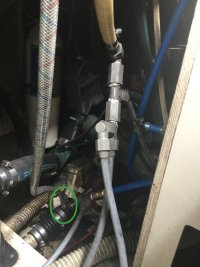@Prairie Schooner and
@trickdhat , if you don’t mind my asking, what is the cost to remove the engine on an Ericson 35-3?
If anyone has had an engine repainted, I would be curious to know the cost of that as well. The paint on mine is peeling and some rust has formed.
I’m also getting a fair amount of belt dust, which I’m guessing is from some misalignment?
Thanks!
Hi Dave,
The short answer is $7500. But we didn't just have the engine pulled. Of that amount, $1500 was parts. We also had a new exhaust riser put in, new water/coolant hoses, replace old copper fuel line with rubber, installation of dripless shaft seal, new mounts installed, service the heat exchanger, everything disconnected then reconnected, alignment, remove and replace coolant, and a two hour sea trial when done. They billed us 7 hours for removing the engine, at $130/hr. I helped the mechanic schlepping gear up the ladder which saved us paying for a second person. Because of ‘supply chain issues’, we probably paid for at least 6 hours of them running around looking for hoses. We were billed about 24 hours to put everything back together. The whole process took almost eight weeks, though that included 4th of July vacation. I’d complain about the time, but to be honest, we were busy with other projects concurrently and wouldn’t have been ready if they had finished a lot sooner.
We purchased separately the dripless shaft seal, new coupler, drive saver, new fuel filter, new raw water pump, new raw water strainer, had the starter and alternator checked/cleaned, had the prop shaft refurbished and prop checked. As detailed elsewhere on this site, I did everything outside, including rebedding the strut.
The oil pan was very rusted and I was especially worried about the tube for the dipstick. While the engine was hanging in the saloon I wire brushed that, was satisfied with its stability, and repainted it. I would have liked to repaint the engine. I personally despise Universal gold and would have painted it all Kubota blue. But I digress into my personal issues.
We had a reputable marine diesel company do the work. We were quite pleased with the end result, but felt they were very inefficient and we paid extra for that. All in all they billed us for about 45 hours. I’m sure we paid a premium for parts, too. I could have eventually done the work myself, but there would have been a lot to learn. And it would have meant scrapping our entire 2022 season. There are a bunch of things I would have liked to do while the engine was out. I try not to think about all that.
I hope that included information that was helpful and not too much that wasn’t. If you have any further questions, I’d be glad to reply.
Upside: we got to go sailing and love being out on our boat.
Cheers,
Jeff













